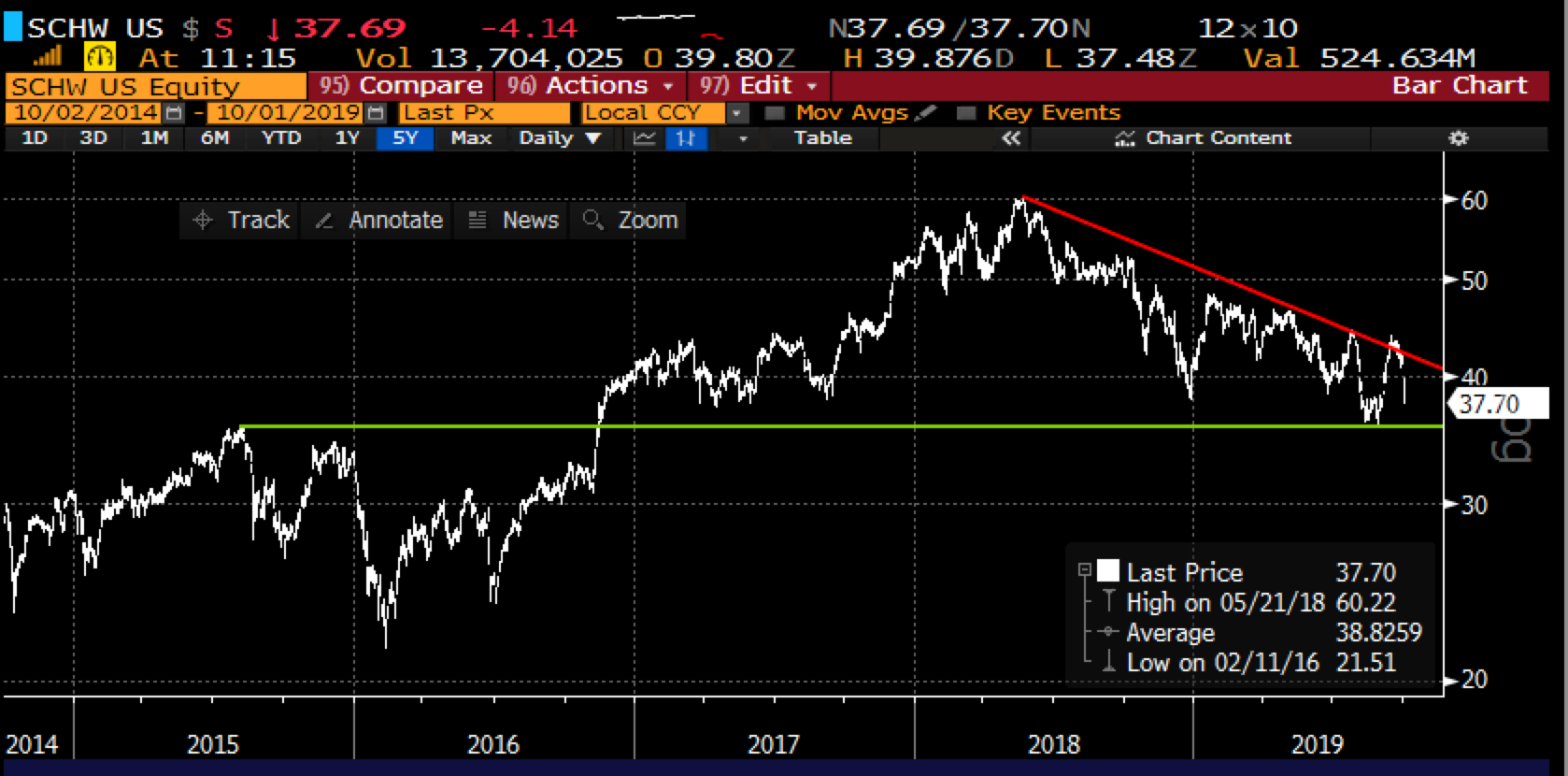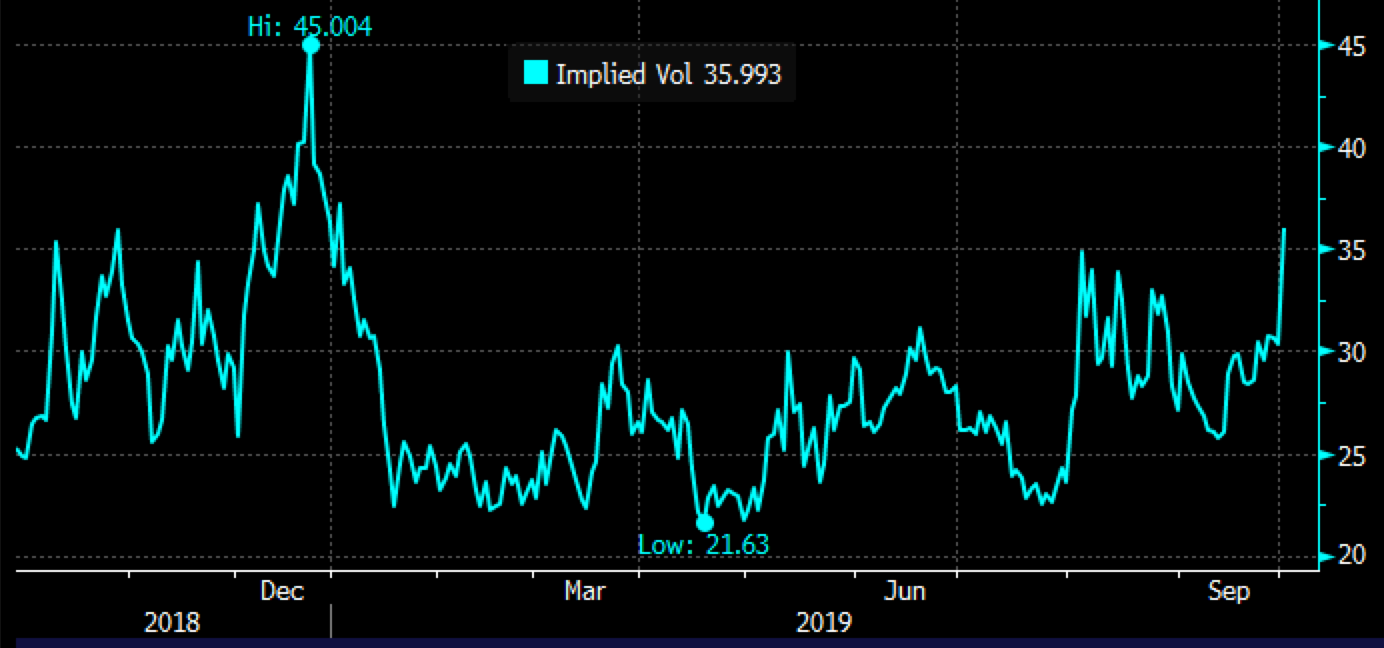Online brokerage companies are getting destroyed today on news that Charles Schwab (SCHW) is going commission-free on online stocks, etf and options trades. Per CNBC:
Starting on October 7, Schwab, which holds about $3.72 trillion in client assets, will be slashing its trading commission cost for U.S. stocks, ETFs and options from the previous $4.95 to zero. Trading options will continue to cost 65 cents per contract. The changes will apply to securities on Canadian exchanges as well.
…
After Silicon Valley start-up Robinhood offered stock trading for free in 2013, analysts predicted it was only a matter of time before the major brokerages were also forced to go to zero. The announcement comes after Interactive Brokers took the same step towards commission free trades on Thursday and J.P. Morgan Chase unveiled its own free trading app in August.
Last summer, Vanguard Group announced investors using its online brokerage platform could trade all ETFs on a commission-free basis.
SCHW and its old-online brokerage peers are fighting a multi-font war as mentioned above not just among themselves (( TD Ameritrade (ATMD), Etrade (ETFC) and Interactive Brokers (IBKR)) wirehouses like Bank of America’s (BAC) Merrill Lynch, UBS etc but also among venture-backed upstarts like Robinhood.
Shares of SCHW, ATMD, ETFC, and IBKWR are getting murdered today, down 11%, 24%, 18% and 9% respectively on the expectation that the race to zero, and loss of commission revenue that “Schwab’s chief financial officer Peter Crawford estimates the commissions fed about $90 million to $100 million in quarterly revenue” on their “current $3.72 trillion” assets under management will be a meaningful hit to their earnings power.
While SCHW’s one day decline of 11% today is less than half of AMTD’s 24% decline, it is worth noting that that SCHW’s decline is greater in market cap terms, with the former losing nearly $5 billion today vs AMTD at around $4 billion.
It would also appear that investors have been bracing for this, at least as evidenced by the stock’s collective performance, with SCHW (as had its peers) has sold off nearly 40% from its all-time highs made in the first half of 2018. Remarkably, SCHW is still 6% from its 52-week lows made in early August, which also marks an important technical support level dating back to its late 2016 breakout level:

The next identifiable catalysts for SCHW should be their Q3 results due out in mid-October. The date has not been confirmed but Bloomberg estimates Oct 15th. The options market is implying about a $2.75 move between now and Oct 18th, or only about 7.5% in either direction, which seems kind of cheap when you consider today’s move and the strong likelihood that the company guides down the balance of the year.
Cheap is a loaded word when it comes to the options market. Short-dated options prices are now trading at new highs for 2019, with 30-day at the money implied volatility near 36%, which would usually suggest that using options to make long premium directional bets has its challenges into events like earnings.

So what’s the Trade? I see little reason to step in front of these stock for the time being, and maybe guidance in a few weeks is another shoe to drop. If you thought that SCHW could play catch-up to the downside and maybe new lows below support, consider the following short-dated put spread:
Bearish Trade Idea: SCHW ($37.50) Buy Oct 18th expiration 37 put for $1.00
This put breaks-even down at $35.95 down 4% in two and a half weeks and should catch earnings, So risking about 3.5% of the stock price to make a defined risk bearish bet into an event after the stock has been down a lot…
As a quick reminder when considering trades like this it usually makes sense to set a premium stop to the downside to managing risk, For instance, if the stock stopped going down, or reversed higher it makes sense to stop the trade at 50% of the premium paid. The more time that passes, and the more the options decay, the less likely of making money, let along breaking even. Also if the stock continued lower it would make sense to spread the long put by selling a lower strike put in oct, reducing the premium at risk and locking in some of the mark to market gains.